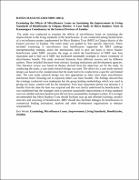| dc.description.abstract | BANDA MASAUSO (2010-M093-10012)
Examining the Effects of Microfinance Loans on Sustaining the Improvement in Living Standards of Beneficiaries in Chipata District: A Case Study of Micro Bankers Trust in Kasenengwa Constituency in the Eastern Province of Zambia.
The study was conducted to examine the effects of microfinance loans on sustaining the improvements in the living standards of the beneficiaries. It was conducted among beneficiaries of a microfinance project implemented by Micro Bankers Trust (MBT) in Chipata district of the Eastern province of Zambia. The entire study was guided by four specific objectives. These included examining if microfinance loan beneficiaries supported by MBT undergo entrepreneurship training, assess the mechanisms used to give out loans to micro finance beneficiaries under MBT, ascertain the stage at which the beneficiaries of MBT start loan repayment and to find out if MBT has facilitated sustainable strategies to ensure continuity of microfinance benefit. The study reviewed literature from different sources and by different authors. These included literature from scholars, learning institutions and development agencies. This literature review was based on themes derived from the objectives set for the study. In conducting the study, a case study research design was used. The choice for a case study research design was based on the consideration that the study had to be conducted in a specific and limited time. The case study research design was also appropriate as there were many microfinance institutions hence choosing one to represent others was more feasible. The findings showed that the trainings conducted were inadequate but the group lending methodology which was used in giving out loans, worked well for the institution. First loan repayment period was between 1-3 months from the time the loan was acquired and this was clearly understood by beneficiaries. It was established that the strategies used to promote sustainable improvements in living standards were not reliable and most beneficiaries did not have sustainability strategies in place. It is strongly recommended that Micro Bankers Trust should facilitate start up and refresher trainings, monitor selection and screening of beneficiaries. MBT should also facilitate linkages for beneficiaries to commercial lending institutions, markets and other development organisations to enhance sustainability.
Key Words: Examining, Microfinance Loans, Improvement, Living Standards, Beneficiaries, Zambia | en_US |


